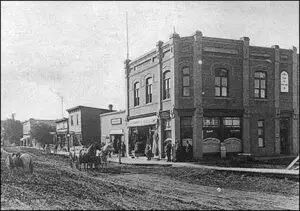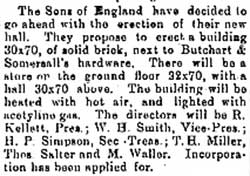March 2021
From requests we’ve received, it seems that for some folks, it’s finally an opportunity to dig into family history, to discover and preserve their roots. Last month, we mentioned a few of these initiatives. Thanks to pandemic closures, our search has been limited pretty much to online sources. That said, here is an update on what we’ve located so far in response to the request for information on the Carman Sons of England Lodge.
Sons of England. You’ll recall that we knew almost nothing about the S.O.E., other than their name on one of the more significant buildings in Carman. Newspapers from the early 1900s noted that the R.M. of Dufferin Council met in the upper chambers of the building and ads identified it as the location over the years of various business ventures. Photos from the 1970s record loss of the building to fire at the time when the Rex Café occupied part of the lower story
The Sons of England Society was one of several benevolent societies from the pre-insurance era that provided support for its members in times of need.
“The Sons of England Benevolent Society was a fraternal society for English Protestants, founded in Toronto, Canada, during the year 1874. Its purpose was to bring Englishmen together for mutual support, social intercourse, and to provide financial security to them and their families in times of sickness, hardship or death. In addition to these aims, the society acted as a cultural organisation, aspiring to preserve and celebrate the Anglo-Protestant cultural heritage of its members.”
The Early History of the Sons of England Benevolent Society: Including its Origin, Principles and Progress
The Winnipeg and Western Canada Directory, p. 93 lists the Carman S.O.E. as Lodge No. 186. Newspaper items from 1898–99 give some insight into construction of their building:
“The Sons of England, of Carman, contemplate the erection of a hall for meetings and are looking for a suitable site.” (Carman Standard, 1898-09-02).
“The Sons of England have bought a lot from Butchart & Somersall and intend erecting a hall for the meetings of their society the first floor will be rented for a general store.” (Carman Standard, 1898-09-16). The same week, the Dufferin Leader (1898-09-15) reported that the lodge had formed a joint stock company and applied for incorporation. “When completed, it will not only be one of the best business stands but one of the best equipped of any in town.”
Sons of England Building early 1900s
The Carman Standard (1898-09-16) provided further details, including the names of the first directors.
The following year, the building was completed and the first-floor tenants had begun to move in [from the Carman Standard, 1899-09-21].
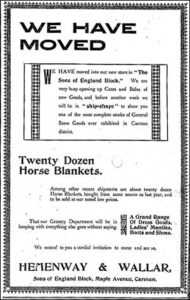
Over the years, changes in businesses can be traced through newspaper ads. So far, we haven’t located any records in family histories or the like of financial aid, however, newspaper reports do record some of the organizations’ social activities.
The Carman Standard (1898-06-24) reported that an S.O.E. excursion was being planned from Carman to Selkirk on July 7th. Tickets for the round-trip cost $2. The committee had arranged a three hour trip up the river for an extra charge of 50 cents. In addition, “Those who desire to take a trip up Lake Winnipeg to Cumberland House can, by taking in this excursion, make the round-trip from Carman for $15.70 including berths and meals on steamer.”
There is no indication of the number of excursionists on this outing, however, the following year, the Dufferin Leader (1899-06-22) reported the S.O.E. excursion was “not as well patronized as it might have been” due to rain and mix-up in departure times. As a result, they had only 200–300 on board when the train pulled out. Wonder what the usual number totalled? On that excursion, the newspaper noted, the excursionists were “met by a reception committee of the Sons of England, of that city, and the trolley cars were in waiting, which conveyed the excursionists to the auditorium instead of Elm Park as previously announced. Here the crowd were entertained with music, etc., until 12 o’clock when they dispersed for dinner. Returning, the excursionists left Winnipeg at 8:30, all feeling that an enjoyable time had been spent.” They apparently were not a group to be daunted by a bit of rain.
The Winnipeg lodge also travelled to Carman. The Carman Standard (1898-06-24) coverage gave an account of the outing and the entertainment provided by the local lodge. Under the heading “S.O.E. Excursion” the newspaper reported that:
“The Sons of England came to Carman on Monday for their annual outing. The first train arrived at 10 o’clock, and the remainder of the excursionists came on the regular train at noon. Headed by the Citizens band the visitors wended their way to Clark’s Grove, where the athletic sports were held, a band concert was given and dancing indulged in. The sports were well contested, a number of fine athletes accompanying the excursion and carrying off most of the prizes…. Carman people took a great deal of interest in the tug of war between Carman and Winnipeg Sons of England. It only required two tugs to decide the superiority of the dwellers on the banks of the Boyne over those who pitched their tents by the Red….
The singing contest or rather the comic songs, created a good deal of amusement. There were about half a dozen entries…. The dancing platform was not well patronized, the day being too warm for that exercise. That antiquated old source of amusement, the Punch and Judy show, bobbed up on the grounds and seemed to draw as of yore. The Citizens band gave an enjoyable concert in the evening opposite the station. The Winnipeg Sons of England are a jolly outfit and seem to know how to get all there is in a picnic out of it. All we have to say to them is “come again”. “
An item in the Dufferin Leader (1899-06-01) gives insight into the patriotic roots of the organization. The article describes an S.O.E. service at St. Andrew’s Church. Forty members of the order paraded from the Orange hall to the church, led by the Carman band. Rev. H.C. Sutherland chose his text a theme from the Psalms, “I have a goodly heritage”. He “began by paying tribute to the greatness of England and the nobility of the Queen. He believed that the finest civilization the world had ever known found its highest expression in England”. Sutherland went on to speak of religion as the chief moulding force in the development of civilization and the key to England’s greatness.
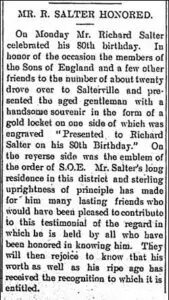
Although we have little information on membership in the S.O.E., the following account from the Dufferin Leader (1899-05-18) gives a hint of the fellowship amongst lodge members. Salterville, to the east of the present-day town of Carman, was the fist post-1870 settlement and post office in the area. We gather from the earlier list of directors that Richard Salter was an early pillar of the organization.
Other early lodges. The SOE was just one of several lodges active in the area around this time. Among other organizations mentioned in local newspapers were the LOL (Loyal Orange Lodge), Masons or AF and AM (Ancient Free and Accepted Masons), IOOF (Independent Order of Odd Fellows), IOF (Independent Order of Foresters) as well as women’s groups such as the IODE (Imperial Order Daughters of the Empire). Look for these initials or organization symbols on grave markers in local cemeteries.
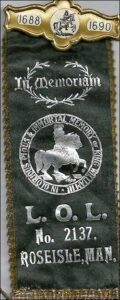
The Orange Lodge figured most prominently in early history of this area. The order was named in honour of Protestant King William of Orange’s defeat of
Catholic King James at the Battle of the Boyne. Irish Protestants in Ontario, stirred up by a push to revenge Riel’s execution of Thomas Scott and secure the West from the Catholics, were strongly represented among the first waves of new settlers.
Samuel Kennedy, the first post-1870 settler to take up a homestead in the area was a staunch member of the L.O.L. He is credited with making a bold statement of his beliefs by renaming the Rivière aux Îlets-de-Bois the Boyne River. The first L.O.L. meetings were held in his home. As settlements spread, several local communities established their own branches of the Lodge.
On July 12, local lodges gathered to march in parades, accompanied by fifes and drums. They also sponsored local community events. The Dufferin Leader (1910-11-03) announced that “Loyal Orange Lodge No. 2137 Roseisle, will give a Grand Ball on the evening of Friday, Nov. 4. On the afternoon of the same day a Turkey Shoot will be held. Admission to ball, $1. Come and bring your girl.”The last remaining local L.O.L hall in Graysville has deteriorated to the point where its valuable records and artifacts have now been donated to the Dufferin Historical Museum. The museum also holds a copy of The Early History of Dufferin Loyal Orange Lodge #1514 Graysville, Manitoba, 1883–1959 by L.O.L. member Dr. T.J. Harrison.
A local RM of Dufferin lodge

